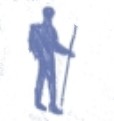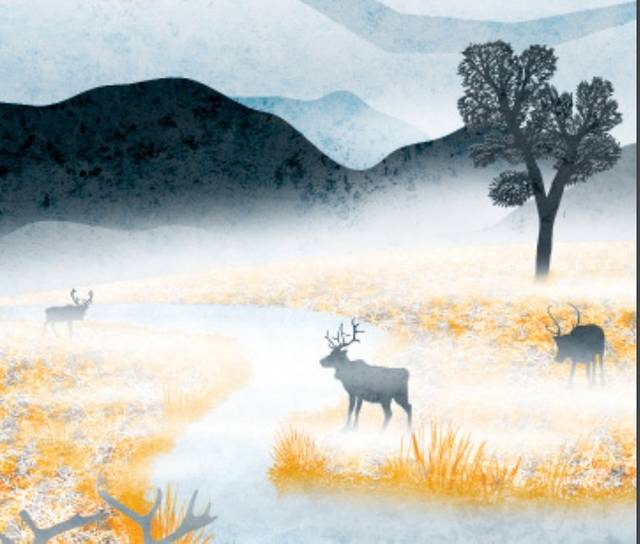Published in Ernest
January 2021
They crossed the North Sea by ship, just like the Vikings did. At first there were only eight of them, four females and four males. The wind was strong, the seas were high; by the time they reached the east coast of Scotland they were weak and ill, and one of them had accidentally gored their herder in the eye so that he arrived wearing a piratical-looking eyepatch. Another died during the group’s month or so in quarantine. The survivors were transported north to colonise a new land.
At first they made themselves at home among the gnarled Scots pines of Rothiemurchus, a remnant of the once-great Caledonian Forest, 9,000 years old, that blanketed the north of Britain after the glaciers melted. The settlement period was hard – their lives were made a misery by tormenting midgies, horseflies and mosquitoes they could do nothing to escape – but the colony was strengthened by a second wave of pioneers, followed by a third, a fourth. Winter brought the snow they loved. And soon they gained their freedom.
The fences were taken down. Beyond the woods lay mountains. Ahead of them, and above, stretched hundreds of square miles of eroded granite peaks, straths (shallow riverine valleys), lairigs (deep glacial passes), clear-flowing rivers, burns and lochs, and flora that they would have known from their homeland in Scandinavia: a landscape swathed abundantly in a squelching weave of sphagnum moss, fork-moss, crimson rustwort, lichens, ferns, monster pawwort, blaeberry and tough montane grass, the only patch of Arctic tundra that exists in Britain. And most importantly of all, an intricate dendritic form of the very palest green that resembles nothing so much as a diagram of a nervous system, growing simply everywhere: reindeer lichen, a crucial part of the new arrivals’ diet.
Reindeer owe their existence in Scotland to a honeymoon. Two years after the Second World War the newly married Dr Ethel Lindgren, a Swedish-American anthropologist, and Mikel Utsi, an indigenous Swedish Sámi reindeer herder, came by train to the eastern edge of the Cairngorms mountain range. ‘Looking across Rothiemurchus Forest to the Cairngorms from the railway bridge at Aviemore on a cold morning in April 1947,’ Utsi later recalled, ‘I was instantly reminded of reindeer pastures in Lapland… species of ground, rock and tree lichens, which are elsewhere the chief food of reindeer, were plentiful and of little use to other animals.’ The similarity to his home – geologically, ecologically and even climatologically (the lowest temperature ever recorded in Britain, minus 27.2 Celsius, has twice been measured in nearby Braemar) – was what gave him the idea. The newlyweds decided to attempt breeding reindeer in Scotland.
It took five years, but, using formidable powers of persuasion – Dr Lindgren in particular had an impressive contacts list – they had won the support of the Ministry of Agriculture and the Forestry Commission, which granted them land to use as an experimental enclosure. Utsi personally accompanied those initial eight individuals on the S.S. Sarek; it was him that got an antler in the eye during the crossing.
Seven decades later, the Cairngorms are home to Britain’s only free-living reindeer herd, with around 150 scattered across the plateau. Being free to roam, they can escape the insects that plagued them at lower altitude, and – despite the chomping mouths and the slow-growing nature of the plant – the lichen appears no less plentiful than it was in Utsi’s day. The herder died in 1979 and Dr Lindgren in 1988, so today’s herd is managed by Tilly and Alan Smith. Tilly came here originally to work as a volunteer. As she told me in an email: ‘I was struck by the beauty of the landscape, the endearing nature of the reindeer and the reindeer keeper (Alan) wasn’t bad-looking! The rest is history.’
The experiment has been so successful that, at the World Reindeer Herders Congress held in north-east China in 2013, the Smiths – alongside Sámis, Soyots, Inuits, Evenks, Chukchis, Komis, Nenets, Iñupiaqs and other herding cultures from around the globe – accepted Scotland’s recognition as the thirtieth member. ‘I have been to congresses in Tromsø, Kautokeina, Jokkmokk and also a council meeting in Salekhard, on the Yamal Peninsula,’ says Tilly. ‘You never know, one day the congress may be held in Scotland.’
This seemingly random string of events – the chance honeymoon of two Swedes that eventually led to Scotland’s ascension to a cervine community that spans the Northern Hemisphere – may sound bizarre, at first. But the story of reindeer in the Cairngorms is older than the 1950s.
You can glimpse them in paleontology: middens of antlers and butchered bones have been unearthed throughout Scotland. As the glaciers of the Ice Age retreated, leaving the straths and lairigs behind – and as the first birches and pines of the future Caledonian Forest took root in the thawing permafrost – Paleolithic hunting groups migrated northwards into new lands, like people cautiously setting forth on a recently drained seabed. They were following reindeer herds, which roamed throughout northern Europe. As the ice melted and the sea levels rose, severing Britain from the Continent, both the reindeer and their hunters were islanded, cut off from larger seasonal patterns of migration. We know little about the relationship between humans and reindeer in that time, but it seems likely that – in common with other animist cultures – these beautiful animals would have found themselves objects of worship.
Whether they were semi-domesticated, like their cousins in Scandinavia – selectively bred for their meat, milk and wondrous warm pelts – is another unknown, lost in prehistory. But we do have hints and clues, distorted through centuries of myth. ‘On milk of deer I was reared/ On milk of deer I was nurtured’, goes the Highlands lullaby Bainne nam Fiadh, ‘Milk of Deer’; perhaps nonsense, or perhaps an echo from before recorded time. Regarded as fairy cattle, deer appear in folk-tales along with their supernatural wards, especially in stories involving the Cailleach. In Celtic mythology the Cailleach is the ‘divine hag’ and also the Queen of Winter, the touch of whose staff freezes the ground; she might be glimpsed on cold nights milking her herd of magic deer.
Are these stories evidence of an ancient Scottish herding culture, one that was supplanted, perhaps, by subsequent waves of invasion? Or do they point – as one theory suggests – to a migration not of people but of oral history? When the Vikings settled in Scotland, they may have brought stories of the Sámi tribes with whom they had coexisted, fought and traded with in the northern reaches of their homeland, a mysterious reindeer-milking folk who lived at the edge of the world. They might have whispered tales of shamans with magical powers of flight, who journeyed between the worlds to the rhythm of reindeer-skin drums; reindeer urine, suffused with psilocybin from fly agaric mushrooms, was drunk for its hallucinogenic and visionary effects (and, in the centuries to come, stories of flying reindeer might have been the origin not only of airborne witches but of Father Christmas’s sleigh).
Whether reindeer were herded or merely hunted, by the landing of the S.S. Sarek they had been absent from Scotland for centuries, if not millennia. When did the last of them disappear? No one really knows. Vikings enter the story again with a single intriguing line from the Orkneyinga saga, written by the Earls of Orkney, describing a reindeer hunt in Caithness in the thirteenth century. Some scholars take this as proof of their survival into medieval times; others claim that the line actually refers to red deer, and that reindeer went extinct in Britain – as they did across Germany, Denmark and southern Scandinavia – 10,000 years earlier.
They have been home for 70 years. Did the reindeer lichen miss them?
It is a grey day in January, unseasonally mild. My friend Dougie and I are walking to Strath Nethy. It is my first morning in the Cairngorms and my heart aches for snow, but there is only bitter rain. The mountains are sodden and purple-brown. Then, across the little stream, appear five reindeer.
In his years of walking these mountains Dougie has never seen them before. Together we stand silently and watch them watching us. Their pelts are white, silver, grey, dun, minutely flecked with black, and snowy ruffs sway around their necks as they stoop to graze. Their antlers sprout like living moss – like reindeer lichen – softly furred. Their sensitive noses twitch. I do not know the stories yet – I am yet to hear the names of Utsi, Lindgren or the Smiths, or folk-songs about milk of deer, or Sámi shamans, Viking earls or the winter-bringing Cailleach – and all I can think about is how beautiful they look, how right they look, standing there in the midst of Scotland’s tundra.
The spell only lasts for a minute or two. We have miles to walk today and perhaps the reindeer do as well. We take the path beside the stream and they turn the other way.
Minutes after they have gone, it begins to snow.
Illustration by Ruth Thorp


